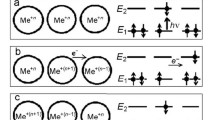Abstract
The thermo-optic coefficient (dn/dT) of inorganic–organic hybrid material films prepared by the sol-gel process of organoalkylsilanes is measured using a prism coupler equipped with a hot stage. The effect of the organic modifier on the variation of dn/dT in inorganic–organic hybrid material films has been investigated. The value of dn/dT becomes more negative with increasing molecular weight of the organic modifier or with an increase in the proportion of modifier in the sample. On the other hand, dn/dT increases with an increase in the degree of organic photopolymerization. From these results, it can be seen that the value of dn/dT in these films can be varied between −0.83 × 10−4/°C to −2.43 × 10−4/°C by changing the organic modifier concentration and type.
Similar content being viewed by others
References
H. Nishihara, M. Haruna, and T. Suhara, Optical Integrated Circuits (McGraw-Hill, New York, 1989), p. 124.
D.N. Nikogosyan, Properties of Optical and Laser-Related Materials (John Wiley & Sons, New York, 1997), p. 169.
P. Michel, J. Duglas, J.M. Cariou, and L. Martin, J. Macromol. Sci., Phys. 25(4), 379 (1986).
J.M. Jewell, J. Non-Cryst. Solids 146, 145 (1992).
T. Izumitani and H. Toratani, J. Non-Cryst. Solids 40, 611 (1980).
S.V. Kartalopoulos, Introduction to DWDM Technology (SPIE Optical Engineering Press, Washington, DC, 2000), p. 141.
Y. Hida, H. Onose, and S. Imamura, IEEE Photo. Tech. 7, 782 (1993).
Y. Kokubun, N. Funato, and M. Takizawa, IEEE Photo. Tech. Lett. 5(11), 1297 (1993).
O.S. Roesch, W. Bernhard, R. Muller-Fiedler, P. Dannberg, A. Brauer, R. Buestrich, and M. Popall, SPIE Proc. 3799, 214 (1999).
E.S. Kang, T.H. Lee, and B.S. Bae, Appl. Phy. Lett. 81(8), 1438 (2002).
D.R. Anderson, Analysis of Silicones (Wiley-Interscience, New York, 1974), Chapter 10.
K. Saravanamuttu, X.M. Du, S.I. Najafi, and M.P. Andrews, Can. J. Chem. 76, 1717 (1998).
O.H. Park, J.I. Jung, and B.S. Bae, J. Mater. Res. 16, 2143 (2001).
L. Prod’homme, Phys. Chem. Glasses. 4, 119 (1960).
J. Zhai, L. Qiu, J. Zhou, Y. Zhao, Y. Shen, Q. Ling, and M. Yang, Adv. Mater. Opt. Electron. 10, 3 (2000).
J. Zhai, L. Qiu, J. Zhou, Y. Zhao, Y. Shen, Q. Ling, and M. Yang, Adv. Mater. Opt. Electron. 10, 3 (2000).
Author information
Authors and Affiliations
Rights and permissions
About this article
Cite this article
Kang, ES., Park, JU. & Bae, BS. Effect of organic modifiers on the thermo-optic characteristics of inorganic–organic hybrid material films. Journal of Materials Research 18, 1889–1894 (2003). https://doi.org/10.1557/JMR.2003.0264
Received:
Accepted:
Published:
Issue Date:
DOI: https://doi.org/10.1557/JMR.2003.0264




